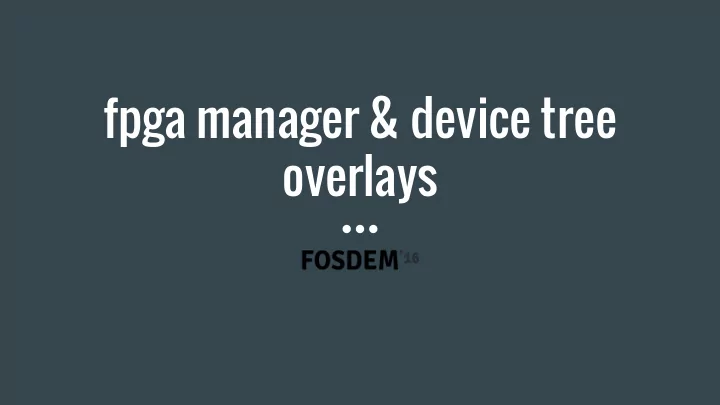

fpga manager & device tree overlays
moritz fischer moritz.fischer@ettus.com mfischer
embedded sdr
wtf?! what does that even mean embedded sdr?
come see other talks tomorrow @ sdr track
so why care about fpgas? performance
so why care about fpgas? reconfigurability
so why care about fpgas? also, they’re awesome
i won’t go into details of fpga design
bitstream (firmware) contains hardware behavior
so how to configure an fpga in a sane way?
let’s start off with a bit of history
vendor solutions
altera $ cat design.rbf > /dev/fpga0 xilinx $ cat design.bin > /dev/xdevcfg
what could possibly go wrong?
well … if you have more than one device implemented in the fpga
userland just goes ahead and reloads the fpga
you maybe have a kernel driver using fpga resources as well ...
ehrm … whoopsie
should the user really care what fpga is in the system?
what if you had more than one fpga?
even worse, hierarchy? (i’m not making these up...)
partial reconfiguration anyone?
fpga manager is vendor neutral as part of linux 4.4 basic support for socfpga and zynq
api - driver ops write_init() /* prepare fpga for reload */ write() /* reconfigure fpga */ write_complete() /* callback when done */ state() /* returns framework internal state */ fpga_remove() /* called when removed */
api usage (kernel) /* get reference from device node */ struct fpga_manager *mgr = of_fpga_mgr_get(dn); /* load bitstream via fw layer*/ fpga_mgr_firmware_load(mgr, flags, “fw.bin”); /* drop reference */ fpga_mgr_put(mgr);
this covers the simple usecase: driver needs fpga bitstream loaded
but we can do better than that ...
let’s talk about device tree overlays
device tree describes hardware, but what if hardware changes?
device tree overlays allow us to add, remove, and modify nodes of the live tree
-- foo.dts (abbrev.)-- example to foo0: foo@0 { compatible = “linux,foo”; status = “disabled”; modify status }; -- overlay.dts (abbrev.) -- property fragment@0 { target = <&foo0>; __overlay__ { status = “okay”; }; };
-- foo.dts (abbrev.) -- example to foo0: foo@0 { compatible = “linux,foo”; [...] }; add bar -- overlay.dts (abbrev.) -- fragment@0 { target = <&foo0>; child __overlay__ { bar0: bar@42 { compatible = “linux,bar”; }; }; };
seriously now, that’s pretty close to what we want, right?
fpga area (still in dev) so DO NOT TRUST THE SLIDES
-- overlay.dts (abbrev.) -- fragment@0 { will look target = <&fpga_mgr0>; __overlay__ { area0: area@40000000 { compatible = “fpga-area”; somewhat like firmware-name = “foo.bin”; c0: child@0 { compatible = “linux,foo” this }; c1: child@4 { compatible = “linux,bar” }; }; }; };
discussion still ongoing, if you care about fpga join the discussion on lkml
some open issues, but seem mostly solvable
what if fpga is pass- through, i.e. soc spi routed through fabric out to a pin?
notifiers? trying to let driver know device is gonna be gone for a bit
fw subsystem doesn’t support (yet) streaming fw for wimpy systems
buckle up … demo time
if we got here, we’re probably out of time … questions?
thanks to these guys alan tull - fpga mgr core, socfpga driver, reviews gregkh - taking my patches pantelis antoniou - dt overlays michal simek - reviews, initial fpga mgr josh cartwright - reviews
-- foo.dts -- btn0: button@0 { compatible = “ettus, example to e3x0-button”; status = “disabled”; }; modify status -- overlay.dts (abbrev.) -- property fragment@0 { target = <&btn0>; __overlay__ { status = “okay”; }; };
Recommend
More recommend